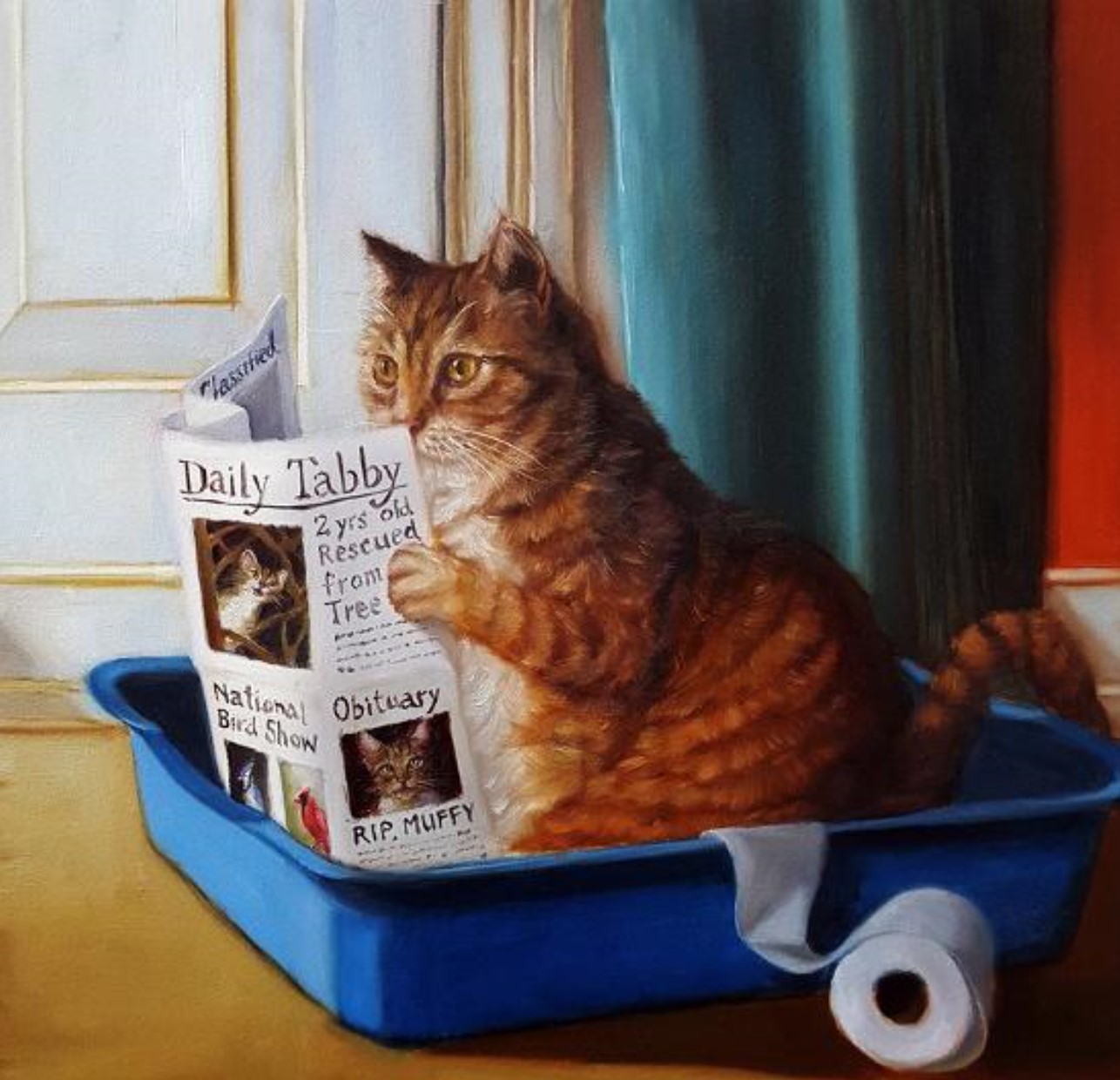URINARY
2 GREAT ARTICLES

WHY DOES MY CAT URINATE OUTSIDE OF THE LITTER BOX?
It is sad to see the number of cats tossed outside to live or taken to a shelter because they begin urinating outside of their litter box Male cats with a bladder problem can become life threatening. Signs can be frequent trips to the litter box, crying out when urinating, urinating only very small amounts, constant licking of genital area; or for many, urinating all over your house. Let’s look at one of the more prominent reasons for this “bad behavior”.
Could Stress Be Causing Your Cat to have Bladder Infections?
Feline idiopathic cystitis (FIC), also known as feline interstitial cystitis, is a stress induced inflammation of the bladder lining, resulting in blood or elevated white blood cells in the urine.
This is caused when your cat’s cortisol levels (stress hormones) increase from stress. An inflammatory response can affect multiple areas in the body, but in cats, veterinarians see it manifest primarily as bladder inflammation.
While sometimes you may be able to point to a recent stressful event, like a family member visiting with a dog or a recent move into a new home, many times we cannot determine conclusively the cause of the stress.
The inflammation in the lining of the bladder can result in bleeding, pain, irritation, and a secondary bacterial infection. This in turn causes its own level of stress, resulting in a vicious cycle. When veterinarians see chronically recurring urinary tract disease, and have ruled out other metabolic disease, crystals or stones as a cause, they will often diagnose feline idiopathic cystitis (FIC) by default, as there is no easy test for this. The only way to definitively diagnose FIC or interstitial cystitis is to do a biopsy of the bladder which is invasive and rarely done.
Initially, veterinarians will treat with antibiotics for secondary infection, pain medications to help block the pain cycle as a stressor, anti-anxiety medications to reduce the cortisol levels from stress, and prescription diets to make the urine less irritating to the inflamed bladder lining.
Until recently, there has been no solution to help treat the reoccurrence of FIC and manage stress with nutrition. Hill’s Science Diet introduced a food that can both promote urinary bladder health and manage stress! By adding tryptophan and a milk protein hydrolysate (hydrolyzed casein), Hill’s Prescription Diet c/d Multicare Stress formula made headlines. Now Royal Canin also has has a urinary diet for stress called Urinary S/O Calm. Both companies offer wet and dry varieties.
If your cat has had reoccurring bladder issues causing them much discomfort, stress may be the culprit. Sometimes the stress can be from lack of stimulation, sort of a boredom stress. Increasing stimulation in the home can help.
Understanding that the indoor environment you provide for your cat(s) did not cause a disease in a previously healthy cat, but rather possibly unmasked an abnormality that they may have been born with. Why do some woman get “bladder infections” and others not? Are they living with stress? Research shows the answer is yes to both humans and our cats. Both may be predisposed to the condition, but with proper stress management, can we avoid the bladder problems?
Research shows that many cats are unusually sensitive to their surroundings. People may not realize how conscious their cat is to something as simple as moving a piece of furniture. Cats are creatures of habit and depend on us to keep their environment stable. Just having someone they are not accustomed to over for dinner can upset them. It can also go in the other direction. Your cat’s environment may be monotonous and predictable, also causing stress.
In a study done by veterinarians at Ohio State University, positive changes made to the environment of indoor cats helped reduce the output of the their stress response system. This stress response system was found to be abnormal in cats with interstitial or idiopathic cystitis.
Let’s start to look at a few ideas of how you can help enrich your feline friend’s living environment starting with their litter box
Litter boxes. The rule is to have one litter box per cat, plus one. I am inclined to agree with this to an extent. There are many inventive ways to accommodate your cat’s “potty preferences”. For example, I am a multi-cat owner (of course), but only have 4 litter boxes Without telling my exact number of cats, let’s just say it’s definitely more than four. But, my litter boxes are actually extra-large storage containers. I love these for many reasons. The sides are high so they don’t splash as much litter out when digging. They are deep so you can fill the litter box with enough litter to give them ample digging satisfaction. Depending on the age and physical condition of your cat, you can alter their litter box accordingly. Find one with one side lower, or cut a tall box yourself, for an elderly feline for example. A box should be big enough for the cat to have plenty of room to move around in searching for the perfect spot to eliminate. Most cats prefer an uncovered box strategically located in a place that gives them some privacy.
Cats look at their “eliminations” as a way to mark their territory as well. Indoor cats consider your house their home…..their territory. We must provide a positive litter box experience so that your cat doesn’t decide to use your couch to announce their territory. Our feline friends are “clean freaks”, so a dirty litter box is a big No No! Scooping twice daily and washing the litter boxes on a monthly basis is a good plan. The type of litter is important to accomplish this plan. The desired litter for cats with urinary problems is the sandy clumping litter. Most cats prefer the unscented kind. You have to remember how sensitive their noses are. What smells a little fragrant to you registers WOW on their sense of smell meter! There should not be any odor if the litter box is kept clean.
With clumping litter, you can measure urine output by the size of the clumps, which is very important in determining a urinary problem. I know there are many types of litter from clay to going green with wheat litter. Whichever you AND YOUR CATS prefer, make sure you keep it clean! Diluted bleach water or a bit of Soft Scrub will do. Also remember that odor can eventually permeate plastic. It is a good idea to replace litter boxes every now and then. You may think they smell clean, but remember our feline friend’s sniffer.
I have had much success using a litter box additive I make with essential oils and baking soda. It is important to buy only food grade quality oils like the ones sold at Cats Meow Veterinary. Our cats are very sensitive to nature’s healing oils and they must be used properly.
Make sure that your cat’s litter box is easily accessible. Consider the path they have to take to the litter box Hopefully, it’s not in a tight spot right next to an appliance they may come on and scare them. Be sure they have a quiet private location so that other animals or humans don’t “sneak up” and startle them.
Bottom line is that cats tend to avoid things that they associate with a negative experience. Making your cat happy with its litter box is good first step in enriching their living environment and hopefully avoiding any inappropriate urination. Keep in mind that all cats are different in their preferences. The above suggestions are a good guide to start with. I always say to play detective. Really try to watch and figure out what is bothering them about their “potty experience”. For example, you may try several different types of litter or litter boxes Sometimes, just something new makes them happy.
I will continue in several more articles to give helpful ideas to help enrich your cats living arrangements. These suggestions are meant to empower you as cat owners by helping you to understand how your efforts can help keep your feline friends happy and healthy.
Feline Interstitial Cystitis
Why Does My Cat Pee Outside It’s Litter Box?
Inappropriate urination, straining in the litter box, blood tinged urine, loss of appetite, hiding. You want to blame it on a bladder infection, but it may not be. Sterile bladder inflammation, known as Feline Interstitial Cystitis (FIC) is the single most common cause of these urinary tract signs in cats.
Here are the top risk factors for cats to develop Feline Interstitial Cystitis (FIC):
- Male cats
- Young, overweight, indoor-only cats
- Cats with nervous or anxious personalities
- Cats that eat a diet of dry food only or more than 50% dry food
- Members of multi-cat households (due to the potential of other cats aggression, especially around litter boxes).
Julie Fischer, DVM, DACVIM, of Veterinary Specialty Hospital San Diego thinks it’s time to get a new program for cats with FIC. Until recent years, cats with urinary tract signs were treated for bladder infections. Many of you still think that if your cat does not receive an antibiotic, it has not been treated properly. I promise, there is often no reason for antibiotics! I personally can attest to years of unnecessary antibiotic therapy until my doctors realized it was simply inflammation in my bladder. FIC cats almost always don’t have an infection either!
Dr. Fischer believes the bladder could be an innocent victim of stress and an overly excitable nervous system. She has found that cats with FIC have neurological characteristics that cause them to be flooded with stress hormones. Interestingly, it seems that a large number of “cat parents” are also going through a lot of stress! I was diagnosed with interstitial cystitis years ago. I can totally relate to a FIC cat’s discomfort. What if we focus our efforts on identifying and reducing our cat’s stress? Maybe then, we will raise awareness of our own stress levels. Our cats can feel when we are upset! Working on recognizing both can result in a better quality of life for our cats and ourselves. Happy cat, happier you. Puurrfect Calm!
FIC cats have some differences in their bodies that are not noted in normal cats. They have larger sensory neurons in part of their spine. It is an understatement to say that FIC cats are sensitive. These cats put out more of a hormone secreted by one of the adrenal glands that has a main function to mobilize the brain and body for action. Stress hormones flood the body of FIC cats. They have a very sensitive “acoustic” startle response that is increased when they are stressed. These cats are in a constant, hyper-excitable state of fight, flight or freeze. Worse than this, they also feel pain more acutely than normal cats. Their pain transmission is actually enhanced!
Dr. Fischer also notes when it comes to the bladder itself, FIC cats experience the same pathology associated with women with interstitial cystitis. Just like me, these cats have a disrupted glycosaminoglycan (GAG) layer in the bladder. Urine is basically toxic waste. The GAG layer protects and lines the bladder. The urine can have poisonous dissolved solutes, bacterial colonization and potassium, which is incredibly irritating, When the GAG barrier or lining of the bladder is disrupted, pain-conducting fibers in the bladder wall are activated. In addition, a damaged and irritated bladder results in inflammation, which causes additional injury to the bladder wall, which can make the cat feel sick. A FIC cat may stop drinking, resulting in even more concentrated urine causing the problems to intensify. Sounds like a miserable way to live, right?
It can be important to provide pain management for cats with acute flare-ups of FIC. Buprenorphine is one good choice, but can be expensive and cause sedation. Another option is gabapentin, which has broad application for management of neurogenic pain – pain produced by the nervous system – (which we have learned can play a big role in FIC). Even more important and what these cats need more than anything is what Dr. Fischer calls “MEMO” (Multi-modal Environmental Modification), along with more water, and dietary changes.
Multi-modal environmental modification, or MEMO, involves inventorying the cat’s environment and identifying potential stressors. Most of us cat lovers do pretty well with meeting our cat’s basic needs of, safety, love and belonging, but fall short of providing them with full environmental enrichment. It’s a key component of managing FIC in cats. Dr. Fischer says we literally need to crawl around the house and think like a cat while we try to identify what represents a feline stress or threat.
After identifying the stressors, you can then modify the environment to make that cat’s nervous system less “hair-triggered”. Ohio State has a good online reference available as part of the Indoor Pet Initiative that can walk you through this process. Visit indoorpet.osu.edu.
Another stressor for cats with FIC can be a history of not being able to engage in typical hunting behavior. Cats have a need to hunt. Problem solving is a significant part of a full and satisfying cat life. Hunting isn’t easy. It takes time, dexterity, physical exertion, cognitive skill and acute sensory concentration. The second part of realizing a cat’s full potential is learning. A great deal of learning occurs in hunting. One false move and prey is lost. Mice can disappear in and out of vegetation, rabbits can scoot down holes and birds can fly away if approached too quickly. Each type of prey presents a unique set of problems. Hunting is wonderfully pleasurable for cats. The reward center of the brain releases endorphins.
It is also important to have protected access to resources (food, water and resting areas). Instead something bothers our cats when they try to access those resources, be it a human, dog, cat, washing machine, buzzing dryer, etc. Another biggie is being bullied by another cat when trying to use the litter box. There is a golden rule of one litter box for every cat plus one. Dr. Fischer also feels one of the main triggers that causes certain cats to flare up with FIC is moving. Nothing disrupts there need for everything to stay the same as moving from one house to another! Cats are creatures of habit.
Nutrition is another important component of managing FIC. Urinary therapeutic diets, especially those with an ingredient to reduce anxiety, have been shown to reduce the incidence of FIC. Canned food diets help by Increasing water intake to speed resolution of signs during an episode, and can help prevent future recurrences, Dr. Fischer says.
So, what about those of you who say, “but I gave my cat antibiotics and the problem went away”?
Dr. Fischer says FIC is a self-limiting condition. Whether your cat takes antibiotics or you give the latest fad of coconut oil, the problem will go away. That’s not to say it won’t come back. You struggle with “why does my cat have another bladder infection”? The right question may be “why is my cat stressed”? To put it another way, cats that suffer from FIC aren’t predisposed to urinary tract infections (UTIs), Dr. Fischer says cats that may be more likely to actually develop a urinary tract infection are very young kittens, cats older than 10 with a chronic disease condition, immunocompromised cats (for example a FIV positive cat), cats that have been previously catheterized, or cats produce a large amount of urine such as a diabetic. A 5-year-old female cat with blood in her urine that vocalizes when she’s urinating is highly unlikely to have a UTI, and doesn’t need antibiotics. She may just need to hunt and have an undisturbed litterbox experience.
Our cats can’t tell us they’re peeing blood because they’re stressed from being bullied by the other cat, or bored to death. Let’s also not forget those cats that are so fat they can’t groom properly, or so arthritic it hurts to move. If we simply throw antibiotics at FIC cats without addressing the underlying stressors that are causing their sickness, we are harming, not helping! If you think about it, why would we want to stuff tablets or liquid down their throat a couple of times a day? These FIC cats are already stressed out!
Cat’s Meow Veterinary tries to use the natural supplements or remedies well before pharmaceutical intervention to help FIC cats manage stress. One example is Zylkene. It is a relatively new product for use in cats for behavioral management. These capsules, which can be put in their food, contain alpha-casozepine – a milk protein. The “science” behind this natural supplement relates to the “warm and fuzzy feeling” that a kitten has when nursing the mother cat. Zylkene can be used for many stressful situations such as thunderstorms (or hurricanes in our area), a new baby, moving, traveling to the vet, fireworks, ETC. It does not cause sedation and can be used short-term or long-term depending on your cat’s needs. Another option is a litterbox powder containing essential oils that are safe for cats. The powder helps draw them back to using their box, as they enjoy the calming effects of the oils. You can also diffuse lavender in the home or place a drop on their favorite spot to take a cat nap.
Be sure to call Cat’s Meow Veterinary Hospital and ask for me, “Cat Lady Kim”, for many more suggestions on solving your cat’s
stress-related issues. And don’t for Dr. Fischer’s – MEMO! Multi-modal environmental modification.


